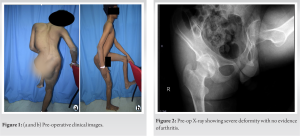In patients with aggressive fibromatosis with no scope of negative margins after resection of the lesion, wide excision and soft-tissue coverage are justified to improve the quality of life in patients with incapacitating deformities.
Dr. Vipin Mohan, Department of Orthopedics, Amrita Institute of Medical Sciences and Research Centre, Kochi, India. E-mail: dr.vipinmohan87@gmail.com
Introduction: Aggressive fibromatosis (AF) is a fibroblastic locally aggressive neoplasm arising from the musculoaponeurotic stroma and has no metastatic potential. The high tendency of recurrence despite complete surgical resections makes the management of the condition onerous. It can result in significant morbidity with major functional loss due to the destruction of adjacent vital structures and organs. AF with hip flexion contracture is a very rare occurrence.
Case Report: A 20-year-old male presented with recurrent abdominal AF with severe hip flexion contracture and an unresectable tumor. He underwent deformity correction and he maintains the full correction achieved along with very good functional improvement at the end of 4 years.
Conclusion: This case demonstrates that in a case of AF with an unresectable tumor, good functional outcome can be obtained; it can be maintained over the short term following contracture release with soft-tissue coverage surgery along with chemotherapy with sorafenib.
Keywords: Aggressive fibromatosis, severe hip flexion deformity, Deformity correction
Aggressive fibromatosis (AF) is a fibroblastic locally aggressive neoplasm arising from the musculoaponeurotic stroma and has no metastatic potential. The high tendency of recurrence despite complete surgical resections makes the management of the condition onerous. It can result in significant morbidity with major functional loss due to the destruction of adjacent vital structures and organs. AF accounts for approximately 0.03% of all neoplasms and arises most commonly in the extremities, abdominal cavity, retroperitoneum, and abdominal wall [1, 2]. Histopathological findings include long fascicles of myofibroblasts arranged in parallel with uniform spacing, in a hypocellular collagenous stroma with infrequent mitosis [3]. Since AF is a benign condition, the cornerstone in the treatment is the management of the symptom and improvement of quality of life, which is achieved with surgical treatment with wide local excision with or without adjuvant therapy [4]. AF is characterized by local aggressiveness with a 20%–30% local recurrence rate but without metastasis. AF resulting in hip contractures has been of extremely rare occurrence and very few cases have been reported on the condition. We present a case of recurrent aggressive abdominal fibromatosis with unresectable lesion and associated severe hip contracture treated by contracture release and the outcome after 4 years.
A 20-year-old man from South India presented with severe fixed flexion deformity of the left hip with a resultant abnormal gait. He is on treatment for abdominal fibromatosis since the age of 11 years but he has not visited the hospital for follow-up for the past 4 years. At the age of 10 years, he underwent a wide excision for a tumor arising in the left iliac fossa at an outside facility and a diagnosis of fibromatosis was done. 1 year later, he developed a recurrence of the lesion and was presented to our hospital. He had undergone tumor excision. At the age of 15 years, he developed recurrence of tumor along with intestinal obstruction for which he underwent tumor excision along with adhesiolysis and left common iliac artery to common femoral artery bypass grafting. After that episode, he did not follow-up in our hospital, but he started developing flexion contracture of the left hip which was slowly increasing. His gait worsened along with the deformity and it had become static according to the patient for the past 1 year. On evaluation, he was found to have 115° of left hip flexion deformity with difficulty in walking (Fig. 1a and b). Clinical examination also demonstrated lumbar scoliosis. Pelvis X-rays revealed the congruent joint space with no evidence of arthritic changes despite the severe deformity (Fig. 2). A computerized tomography angiogram and magnetic resonance imaging were done which revealed recurrence of the lesion approximately 7.4 cm × 7.5 cm × 12.5 cm and is seen infiltrating into the left iliopsoas and displacing the bowel anteriorly and aorta to the right. Tumor is seen to extend into the left iliac inguinal region along the iliac vessels. The iliofemoral graft is encased by tumor and appears compressed at the origin. The extent of the lesion rendered the wide excision of the lesion unfeasible, and hence, it was planned to address the hip contracture which was affecting all the activities of daily living of the patient. He underwent contracture release and flap cover pedicled myofasciocutaneous flap (extended anterolateral thigh flap with fascia lata). All contracted muscles were released including sartorius and iliopsoas. Contracture release has done till the hip joint and joint the capsule are released to achieve extension of the hip with a 15° residual flexion deformity (Fig. 3a, b, c).
A computerized tomography angiogram and magnetic resonance imaging were done which revealed recurrence of the lesion approximately 7.4 cm × 7.5 cm × 12.5 cm and is seen infiltrating into the left iliopsoas and displacing the bowel anteriorly and aorta to the right. Tumor is seen to extend into the left iliac inguinal region along the iliac vessels. The iliofemoral graft is encased by tumor and appears compressed at the origin. The extent of the lesion rendered the wide excision of the lesion unfeasible, and hence, it was planned to address the hip contracture which was affecting all the activities of daily living of the patient. He underwent contracture release and flap cover pedicled myofasciocutaneous flap (extended anterolateral thigh flap with fascia lata). All contracted muscles were released including sartorius and iliopsoas. Contracture release has done till the hip joint and joint the capsule are released to achieve extension of the hip with a 15° residual flexion deformity (Fig. 3a, b, c).
Postoperatively, skin traction was given for 1 week and once the pain improved, he was started on hip extensor and abductor strengthening exercises. Sorafenib has been reported to be effective in a recent randomized control trial [5]. In view of the unresectable residual disease in the abdominal wall, the patient was started on sorafenib an oral multitargeted receptor tyrosine kinase inhibitor (400 mg tablet once daily) post-operatively with monitoring for side effects. It is worth mentioning that a recent study recommends a lower dose of sorafenib (200 mg daily) as effective and well tolerated in Indian patients with desmoid-type fibromatosis [6]. He is on periodical review after the surgery and during the last visit, he did not show any signs of recurrence; however, there was limb length shortening of 5 cm which was managed with shoe raise and has persistent scoliosis. 4 years following the surgery, he is exhibiting no features of recurrence of the deformity and is ambulating well with a shoe lift to manage the 5 cm shortening of the limb (Fig. 4a and b).
Hip flexion contracture is a very rare manifestation of AF. The literature on this particular problem is scarce. Hashimoto et al. have reported a case of fibromatosis arising from the gluteal region resulting in hip contracture and its treatment by tumor resection. After 4 years of follow-up, they observed no recurrence of the lesion or deformity [7]. Ruiz-Osuna et al. [8] reported a case of gluteal fibromatosis (with past history of septic arthritis) with hip flexion deformity and joint destruction treated by physical therapy and providing symptomatic relief. Shay et al. [9] report a case where resection of the desmoid tumor in the gluteus minimus restoring the normal gait. However, the deformity and gait abnormality were less severe than the present case. The challenges of our case are the severity of the deformity and un-resectability of tumor. It is also known that abdominal fibromatosis has a pronounced effect on all aspects of emotional distress [10]. A young adult with severe handicap warranted intervention to improve the quality of his life even though high chances of recurrence are a possibility. After undergoing deformity correction, the patient’s ambulatory capacity improved significantly and he did not develop any recurrence of the deformity and maintaining very good functional improvement at the end of 4 years.
The mainstay in the treatment of AF is wide excision with negative margins. Even then, the condition carries high rates of local recurrence. The case we are reporting is one such case that recurred with an unresectable lesion and resultant severe hip flexion deformity. Contracture release with soft-tissue coverage procedure followed by sorafenib therapy resulted in the significant correction of the hip flexion deformity which the patient maintains after 4 years.
Even in cases with no scope of negative margins after resection, severe deformities and functional compromise can be addressed by wide excision and soft-tissue coverage.
References
- 1.De Bree E, Keus R, Melissas J, Tsiftsis D, Van Coevorden F. Desmoid tumors: Need for an individualized approach. Expert Rev Anticancer Ther 2009;9:525-35. [Google Scholar]
- 2.Howard JH, Pollock RE. Intra-abdominal and abdominal wall desmoid fibromatosis. Oncol Ther 2016;4:57-72. [Google Scholar]
- 3.Fisher C, Thway K. Aggressive fibromatosis. Pathology 2014;46:135-40. [Google Scholar]
- 4.Higaki S, Tateishi A, Ohno T, Abe S, Ogawa K, Iijima T, et al. Surgical treatment of extra-abdominal desmoid tumours (aggressive fibromatoses). Int Orthop 1995;19:383-9. [Google Scholar]
- 5.Gounder MM, Mahoney MR, Van Tine BA, Ravi V, Attia S, Deshpande HA, et al. Sorafenib for advanced and refractory desmoid tumors. N Engl J Med 2018;379:2417-28. [Google Scholar]
- 6.Garg V, Gangadharaiah BB, Rastogi S, Upadhyay A, Barwad A, Dhamija E, et al. Efficacy and tolerability of sorafenib in desmoid-type fibromatosis: A need to review dose. Eur J Cancer 2023;186:142-50. [Google Scholar]
- 7.Hashimoto K, Nishimura S, Toriumi K, Iemura S, Oka N, Akagi M. Desmoid tumor causing hip joint contracture: A case report. Open J Orthop 2018;8:175-82. [Google Scholar]
- 8.Ruiz-Osuna C, Ávila-Zamorano ML, López-Durán A, de la Mora MG, Isunza-Ramírez A. Aggressive pediatric hip fibromatosis with severe joint destruction. A case report. Acta Ortop Mex 2010;24:267-72. [Google Scholar]
- 9.Shay T, Oded H, Noga S, Aharon C, Boaz L. A reversible severe gait disorder caused by an unusual presentation of a musculoskeletal desmoid tumor: A case report. Int J Case Rep Images 2012;3:26-9. [Google Scholar]
- 10.Ingley KM, Klein R, Theobalds N, Burtenshaw S, Abdul Razak AR, Chen B, et al. High prevalence of persistent emotional distress in desmoid tumor. Psychooncology 2020;29:311-20. [Google Scholar]











